
The Sega Saturn is a home video game console developed by Sega and released on November 22, 1994, in Japan, May 11, 1995, in North America, and July 8, 1995, in Europe. Part of the fifth generation of video game consoles, it is the successor to the successful Genesis. The Saturn has a dual-CPU architecture and eight processors. Its games are in CD-ROM format, including several ports of arcade games and original games.

Soul Edge is a fighting game developed by the Namco team Project Soul and published by Namco as the first installment in the Soulcalibur series of 3D fighting games. Introduced at the JAMMA trade show in November 1995, the full arcade game was released in early 1996, while later in December an upgraded and expanded version of the game was ported to the PlayStation. The PlayStation version was renamed Soul Blade in North America, Europe, and Australia.
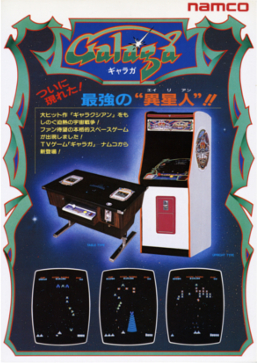
Galaga is a 1981 fixed shooter arcade video game developed and published by Namco. In North America, it was released by Midway Manufacturing. It is the sequel to Galaxian (1979), Namco's first major video game hit in arcades. Controlling a starship, the player is tasked with destroying the Galaga forces in each stage while avoiding enemies and projectiles. Some enemies can capture a player's ship via a tractor beam, which can be rescued to transform the player into a "dual fighter" with additional firepower.

Dig Dug is a maze arcade video game released by Namco in 1982. It was distributed in North America by Atari, Inc. The player digs underground tunnels to attack enemies in each level, by either inflating them to bursting or crushing them underneath rocks.

Xevious is a vertically scrolling shooter arcade video game developed and published by Namco in 1982. It was released in Japan by Namco and in North America by Atari, Inc. Controlling the Solvalou starship, the player attacks Xevious forces before they destroy all of mankind. The Solvalou has two weapons at its disposal: a zapper to destroy flying craft, and a blaster to bomb ground installations and enemies. It runs on the Namco Galaga arcade system.

Rally-X is a maze chase arcade video game developed in Japan and Germany by Namco and released in 1980. In North America, it was distributed by Midway Manufacturing and in Europe by Karateco. Players drive a blue Formula One race car through a multidirectional scrolling maze to collect yellow flags. Boulders block some paths and must be avoided. Red enemy cars pursue the player in an attempt to collide with them. Red cars can be temporarily stunned by laying down smoke screens at the cost of fuel. Rally-X is one of the first games with bonus stages and continuously-playing background music.
Namco Museum is a series of video game compilations developed and published by Bandai Namco Entertainment for home video game consoles. The first title in the series, Namco Museum Vol. 1, was released for the PlayStation in 1995. Entries in the series have been released for multiple platforms, including the Game Boy Advance, PlayStation 2, PlayStation Portable, Nintendo DS and Xbox 360. the latest being Namco Museum Archives Vol. 2, released in 2020.

Rage Racer is the third title in the Ridge Racer series of racing games on the PlayStation. Developed and published by Namco, it was released in Japan on December 3, 1996, with releases in the U.S. and Europe following in 1997. It was the first game in the series to feature a CGI animated introduction, and introduced a new "mascot", Reiko Nagase.
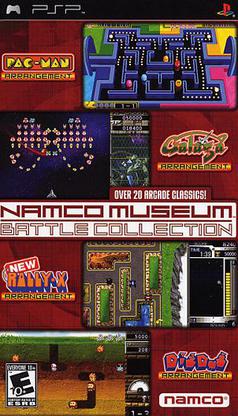
Namco Museum Battle Collection is a 2005 video game compilation developed by Tose and published by Namco for the PlayStation Portable; the first Namco Museum since the PS1 series to be developed in Japan. It includes 21 games - four of these are brand-new "arrangement" remakes of older Namco games, while the rest are emulated ports of Namco arcade games from the 1970s and 1980s. These ports include an options menu that allows the player to modify the in-game settings, such as the screen orientation and number of lives. Players can send one-level demos to a friend's console via the "Game Sharing" option in the main menu.

Toy Pop is a multidirectional shooter arcade game that was released by Namco in 1986. The game was later rereleased as part of Namco Museum Vol. 1 for the original Sony PlayStation in 1995.

Namco Classic Collection Vol. 1 is a 1995 arcade game compilation developed and published by Namco. It includes three of the company's most well-known games from the early 1980s — Galaga (1981), Xevious (1983), and Mappy (1983) — alongside brand-new "Arrangement" remakes of these games that have updated gameplay, visuals, and sounds. The arcade originals are also modified slightly to end after a certain number of rounds. Super Xevious (1984) is also playable. It ran on the Namco ND-1 arcade system, being one of the first games to utilize it.

Xevious 3D/G is a 1996 vertically scrolling shooter arcade video game developed and published by Namco. The eighth entry in the Xevious series, it combines 2D-based gameplay with 3D gouraud-shaded polygon graphics. Players control the Solvalou starship in its mission to destroy a rogue supercomputer named GAMP and the Xevian Forces, using two basic weapon types - an air zapper to destroy air targets, and a blaster bomb to destroy ground targets. The game also features destructive power-ups, new bosses, and two player simultaneous play.

Ridge Racer is a 1993 racing video game developed and published by Namco. It was released initially on the Namco System 22 arcade system board and ported to the PlayStation console in 1994. It is the first title in the Ridge Racer series released for arcades and home consoles.

Namco Museum Remix is a 2007 video game compilation developed and published for the Wii by Namco Bandai Games. The compilation includes nine Namco arcade games and five "remix" games made specifically for this compilation. A remake, Namco Museum Megamix, was released exclusively in North America on November 26, 2010; the game features nine other arcade games alongside the titles from the original, as well as an additional remix game based on Grobda.
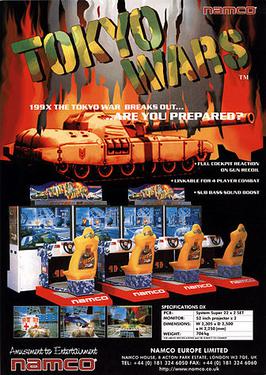
Tokyo Wars is a 1996 first-person shooter arcade game developed and published by Namco.

Pac-Man Championship Edition is a 2007 maze video game developed and published by Namco Bandai Games for the Xbox 360. It has since appeared on several other platforms, including iOS, Android, and the PlayStation 3 and PlayStation Portable as a PSP mini title available on the PlayStation Store. It is an HD reimagining of the original Pac-Man arcade game; players navigate Pac-Man through an enclosed maze, eating pellets and avoiding four ghosts that pursue him. Clearing an entire side of the maze of dots will cause a fruit item to appear, and eating it will cause a new maze to appear on the opposite side.
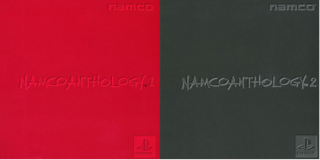
Namco Anthology is a 1998 duology of video game compilations developed and released by Namco for the PlayStation exclusively in Japan. The two collections compile several Namco-published video games for the Family Computer, Super Famicom, and Mega Drive, in a manner similar to the company's existing Namco Museum series. Alongside ports of the original games are remakes of each game that feature enhanced graphics, sound, and gameplay.
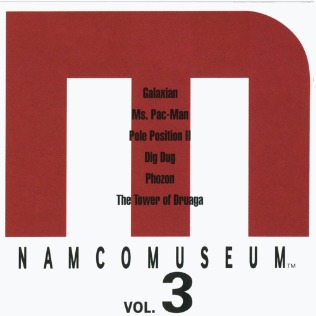
Namco Museum Vol. 3 is a video game compilation developed by Now Production for PlayStation in 1996-1997. It is the third game in the Namco Museum series.

Namco Museum Vol. 1 is a 1995 arcade video game compilation developed and published by Namco for the PlayStation. The collection includes seven arcade games developed by the company that were originally released in the 1980s, such as Pac-Man, Galaga and Pole Position. The compilation features a 3D open-world virtual museum that the player can interact with, the games being housed in themed rooms with exhibits, such as promotional flyers, cabinet artwork and instruction cards. Players can also view Namco product catalogs, promotional pamphlets and front cover scans of the company's Japanese press literature.


















